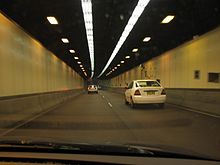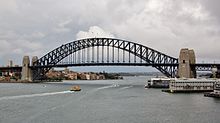Sydney Harbour Tunnel
 Sydney Harbour Tunnel, northbound | |||||||||||||||||||||||||||||||||||
| Overview | |||||||||||||||||||||||||||||||||||
|---|---|---|---|---|---|---|---|---|---|---|---|---|---|---|---|---|---|---|---|---|---|---|---|---|---|---|---|---|---|---|---|---|---|---|---|
| Location | Port Jackson | ||||||||||||||||||||||||||||||||||
| Coordinates | 33°51′09″S 151°12′43″E / 33.85260°S 151.21187°E | ||||||||||||||||||||||||||||||||||
| Status | Active | ||||||||||||||||||||||||||||||||||
| Route | |||||||||||||||||||||||||||||||||||
| Start | |||||||||||||||||||||||||||||||||||
| End | |||||||||||||||||||||||||||||||||||
| |||||||||||||||||||||||||||||||||||
The Sydney Harbour Tunnel is a twin-tube road tunnel in Sydney. The tunnel was completed and opened to traffic in August 1992 to provide a second vehicular crossing of Sydney Harbour to alleviate congestion on the Sydney Harbour Bridge.
The tunnel joins the Warringah Freeway at North Sydney, and the Cahill Expressway at the entrance to the Domain Tunnel. It has two lanes in each direction, and runs at an angle of approximately thirty degrees (North to South) to the Sydney Harbour Bridge, which has eight lanes, with a tidal flow operation. In 2008, the tunnel was carrying around 90,000 vehicles per day.[1][3]
Construction
The tunnel is made up of three sections: twin 900-metre land tunnels on the north shore, twin 400-metre land tunnels on the south shore and a 960-metre immersed tube (IMT) structure. The tunnel falls about 55 metres from the northern entrance and about 35 metres from the southern entrance to its deepest point, 25 metres below sea level.
The IMT structure consists of eight precast concrete units. The units were constructed over 100 kilometres away in a casting basin at Port Kembla and then towed to Sydney Harbour. A trench was dredged before the arrival of the IMTs and then the IMTs were lowered into the trench by a system of pontoons and control towers. After the IMTs were in place the trenches were backfilled and then a rock armour was placed over the top to protect the units against marine hazards, such as anchors or sinking vessels.
The land tunnels were constructed by a combination of driving and cut-and-cover techniques. The total construction cost of the project was A$554.25 million, and was designed to be strong enough to withstand the impact of earthquakes and sinking ships.
The northern end pylons of the Sydney Harbour Bridge were altered to allow for air exhaust from the tunnel to rise over the harbour. Bradfield Park on the northern side of the bridge also has air intakes.

Fresh air is drawn by an underground ventilation station on the north shore and is pumped to all sections of the tunnel through vented ducts. The air supply uses fourteen axial flow fans, each up to 2.5 metres in diameter. The exhaust uses sixteen (eight in each northern pylon tower) fans that draw exhaust air through two underground ducts from the tunnel ventillation station and transfer the air to the top of the pylon. They can expel it at up to 1 500 m³/s – equivalent to changing all the air in the tunnel every two minutes[4] with the capability of running in reverse in an emergency and all fans are rated for smoke extraction. Each of the fans has a duty of 53 to 103 m³/s. The testing of the fans was one of the most comprehensive ever, covering flowrate and pressure, power measurements, sound levels, bearing vibration, x-raying of all impeller components, high-temperature tests at 200 °C for 2 hours, impeller strain, and 24-hour run tests for reversals.[5]
The tunnel was opened to the public to walk through from North Sydney (Falcon Street) to South Sydney (The Domain) on 30 August 1992. The proceeds of the tickets sold for this event were donated to the Royal Institute for Deaf and Blind Children. The tunnel opened to traffic on 31 August 1992.[6]
Operator
The Harbour Tunnel is a partnership between the Government of New South Wales and private investors by tender. Transfield Pty Limited and Kumagai Gumi formed a 50/50 joint venture company which constructed the tunnel under contract; with a 30-year operating contract, including revenue collection and maintenance, from 1992 until 2022. As a result of the 1997 separation of assets of Transfield and the creation of the Tenix group, the ongoing thirty-year operating contract for management of the tunnel is split between Kumagai Gumi (50%), Transfield (25%) and Tenix (25%). At the conclusion of the operating contract in August 2022, the tunnel is to be handed back to the NSW Government.[1][7]
There was a lot of scepticism surrounding the appointment of Transfield to build the tunnel, after other projects including IMT tunnels, carried out by the group, developed structural problems resulting in leaks.[citation needed]
Tolling
In 2006, the New South Wales Government announced that all cash tolls on the Sydney Orbital Network will cease by 2010.[8] The Sydney Harbour Tunnel went fully electronic in July 2007 with both e-TAG and e-pass video tolling arrangements in use, similar to technologies used the Westlink M7, Cross City Tunnel and the Lane Cove Tunnel.[9] This measure has substantially eased the traffic jams heading towards the electronic gantries, and providing increased convenience and time savings. The Sydney Harbour Tunnel attracts a varying toll (that was introduced in 2009) of between A$2.50 and A$4.00, depending on the time of day.[10] The toll is levied on the southbound approach to the tunnel entrance.
Exits and interchanges

| LGA | Location | km | mi | Destinations | Notes |
|---|---|---|---|---|---|
| North Sydney Council | North Sydney | 0.0 | 0.0 | Northern end of tunnel | |
| Port Jackson | Sydney Harbour Tunnel | ||||
| City of Sydney | Sydney | 2.8 | 1.7 | Southern end of tunnel | |
| 1.000 mi = 1.609 km; 1.000 km = 0.621 mi | |||||
See also
Notes
- RTA, Live Traffic NSW – Approaching the Sydney Harbour Tunnel, southbound
- Cory, W. T. W (Bill) (2005). Fans & ventilation: a practical guide (hardback). Amsterdam; Boston: Elsevier in association with Roles & Assoc. p. 424. ISBN 0-08-044626-4 (reproduced from the original published in the The Daily Telegraph-Mirror Harbour Tunnel souvenir).
{{cite book}}: CS1 maint: postscript (link) - Pratley, Juliet (1993). "Sydney Harbour Tunnel". Concrete International. 15 (7): 19–23.
References
- ^ a b c Robins, Brian; Besser, Linton (11 December 2008). "Sydney Harbour tunnel a $1b black hole". The Sydney Morning Herald. Retrieved 1 February 2011.
- ^ a b Muhammad, Imran; Low, Nicholas (December 2006). Mega Projects in Transport and Development: Background in Australian Case Studies. Australasian Centre for the Governance and Management of Urban Transport. Accessed 3 July 2009.
- ^ Ralston, Nick (11 December 2008). "Harbour tunnel still good value: govt". The Sydney Morning Herald. Retrieved 1 February 2011.
- ^ Bill Cory, Australian Telegraph Mirror Harbour Tunnel Souvenir, illustrating the novel approach taken, courtesy of The News Ltd, Sydney Australia republished in Fans and Ventilation-A Practical Guide, p. 17
- ^ Bill Cory, Fans and Ventilation-A Practical Guide, p. 18
- ^ "Sydney Harbour Tunnel". Building Sydney motorways. Roads and Maritime Services. 31 October 2011. Retrieved 5 March 2012.
- ^ McDonald, Hamish (12 March 2011). "Take a look north for the road ahead". The Sydney Morning Herald. Retrieved 3 August 2011.
- ^ Aston, Heath (25 April 2007). "Sydney toll network dumps coins". The Daily Telegraph. Australia. Retrieved 3 August 2011.
- ^ Aston, Heath (5 July 2007). "Drivers' gridlock on e-tags". The Daily Telegraph. Australia. Retrieved 3 August 2011.
- ^ Haynes, Rhys (19 July 2011). "Peak-hour tolls on the Harbour Bridge and Tunnel could be scrapped". The Daily Telegraph. Australia. Retrieved 3 August 2011.
